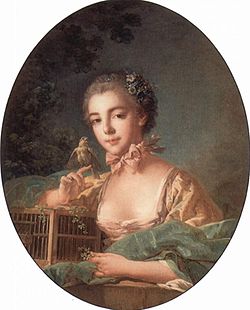
Musée Cognacq-Jay
Encyclopedia

Paris
Paris is the capital and largest city in France, situated on the river Seine, in northern France, at the heart of the Île-de-France region...
, France
France
The French Republic , The French Republic , The French Republic , (commonly known as France , is a unitary semi-presidential republic in Western Europe with several overseas territories and islands located on other continents and in the Indian, Pacific, and Atlantic oceans. Metropolitan France...
. It is open daily except Monday; admission is free. The nearest Metro stations are Saint-Paul
Saint-Paul (Paris Metro)
Saint-Paul is a station on Paris Métro Line 1. It serves the neighbourhood of Le Marais, known for its Jewish and gay communities. The Jewish quarter is called Pletzl and is located around the Rue des Rosiers...
and Chemin Vert
Chemin Vert (Paris Metro)
Chemin Vert is a station of the Paris Métro, named after the Rue de Chemin Vert.The station opened on 5 May 1931 with the extension of the line from Richelieu - Drouot to Porte de Charenton. The Rue de Chemin Vert follows the route of an old foot path through the middle of market gardens...
.
The museum's collection was formed between 1900–1925 by Théodore-Ernest Cognacq (1839-1928) and his wife Marie-Louise Jay (1838–1925), founders of La Samaritaine
La Samaritaine
La Samaritaine was a large department store in Paris, France, located in the First Arrondissement. The nearest metro station is Pont-Neuf. It is currently owned by LVMH, a luxury-goods maker. The store, which had been operating at a loss since the 1970s, was finally closed in 2005 because the...
department store. At his death, Cognacq gave the collection to the City of Paris, which in 1929 inaugurated the Musée Cognacq-Jay at 25 boulevard des Capucines. In 1990 it was moved to the Hôtel Donon (circa 1575) in the Marais
Le Marais
Le Marais is a historic district in Paris, France. Long the aristocratic district of Paris, it hosts many outstanding buildings of historic and architectural importance...
, where the collection is displayed in twenty paneled rooms (four floors) in the styles of Louis XV and Louis XVI.
The museum contains an exceptional collection of fine art and decorative items, about 1200 items in total, with an emphasis on 18th century France, ranging from European and Chinese ceramics, jewels, and snuffboxes, to paintings by Louis-Léopold Boilly, François Boucher
François Boucher
François Boucher was a French painter, a proponent of Rococo taste, known for his idyllic and voluptuous paintings on classical themes, decorative allegories representing the arts or pastoral occupations, intended as a sort of two-dimensional furniture...
, Canaletto
Canaletto
Giovanni Antonio Canal better known as Canaletto , was a Venetian painter famous for his landscapes, or vedute, of Venice. He was also an important printmaker in etching.- Early career :...
, Jean-Siméon Chardin, Jean-Honoré Fragonard
Jean-Honoré Fragonard
Jean-Honoré Fragonard was a French painter and printmaker whose late Rococo manner was distinguished by remarkable facility, exuberance, and hedonism. One of the most prolific artists active in the last decades of the Ancien Régime, Fragonard produced more than 550 paintings , of which only five...
, Jean-Baptiste Greuze
Jean-Baptiste Greuze
Jean-Baptiste Greuze was a French painter.-Early life:He was born at Tournus, Saône-et-Loire. He is generally said to have formed his own talent; this is, however, true only in the most limited sense, for at an early age his inclinations, though thwarted by his father, were encouraged by a...
, Maurice Quentin de La Tour
Maurice Quentin de La Tour
Maurice Quentin de La Tour was a French Rococo portraitist who worked primarily with pastels. Among his most famous subjects were Voltaire, Rousseau, Louis XV and Madame de Pompadour.-Biography:...
, Sir Thomas Lawrence, Hubert Robert
Hubert Robert
Hubert Robert , French artist, was born in Paris.His father, Nicolas Robert, was in the service of François-Joseph de Choiseul, marquis de Stainville a leading diplomat from Lorraine...
, Giovanni Battista Tiepolo
Giovanni Battista Tiepolo
Giovanni Battista Tiepolo , also known as Gianbattista or Giambattista Tiepolo, was an Italian painter and printmaker from the Republic of Venice...
, and Jean-Antoine Watteau; sculpture by Jean-Antoine Houdon
Jean-Antoine Houdon
Jean-Antoine Houdon was a French neoclassical sculptor. Houdon is famous for his portrait busts and statues of philosophers, inventors and political figures of the Enlightenment...
, Jean-Baptiste Lemoyne
Jean-Baptiste Lemoyne
Jean-Baptiste Lemoyne was a French sculptor, among the greatest French portraitists. He was the pupil of his father, Jean-Louis Lemoyne, and of Robert Le Lorrain....
, and Jacques-François-Joseph Saly; and fine furniture attributed to Jean-François Oeben
Jean-François Oeben
Jean-François Oeben, or Johann Franz Oeben was a French cabinetmaker whose career was spent in Paris. He is the maternal grandfather of the painter Eugène Delacroix....
and Roger Van der Cruse. 17th century is also represented, notably with two paintings by Rembrandt while 19th century is represented with works by Camille Corot, Paul Cézanne
Paul Cézanne
Paul Cézanne was a French artist and Post-Impressionist painter whose work laid the foundations of the transition from the 19th century conception of artistic endeavour to a new and radically different world of art in the 20th century. Cézanne can be said to form the bridge between late 19th...
and also Edgar Degas
Edgar Degas
Edgar Degas[p] , born Hilaire-Germain-Edgar De Gas, was a French artist famous for his work in painting, sculpture, printmaking and drawing. He is regarded as one of the founders of Impressionism although he rejected the term, and preferred to be called a realist...
.

